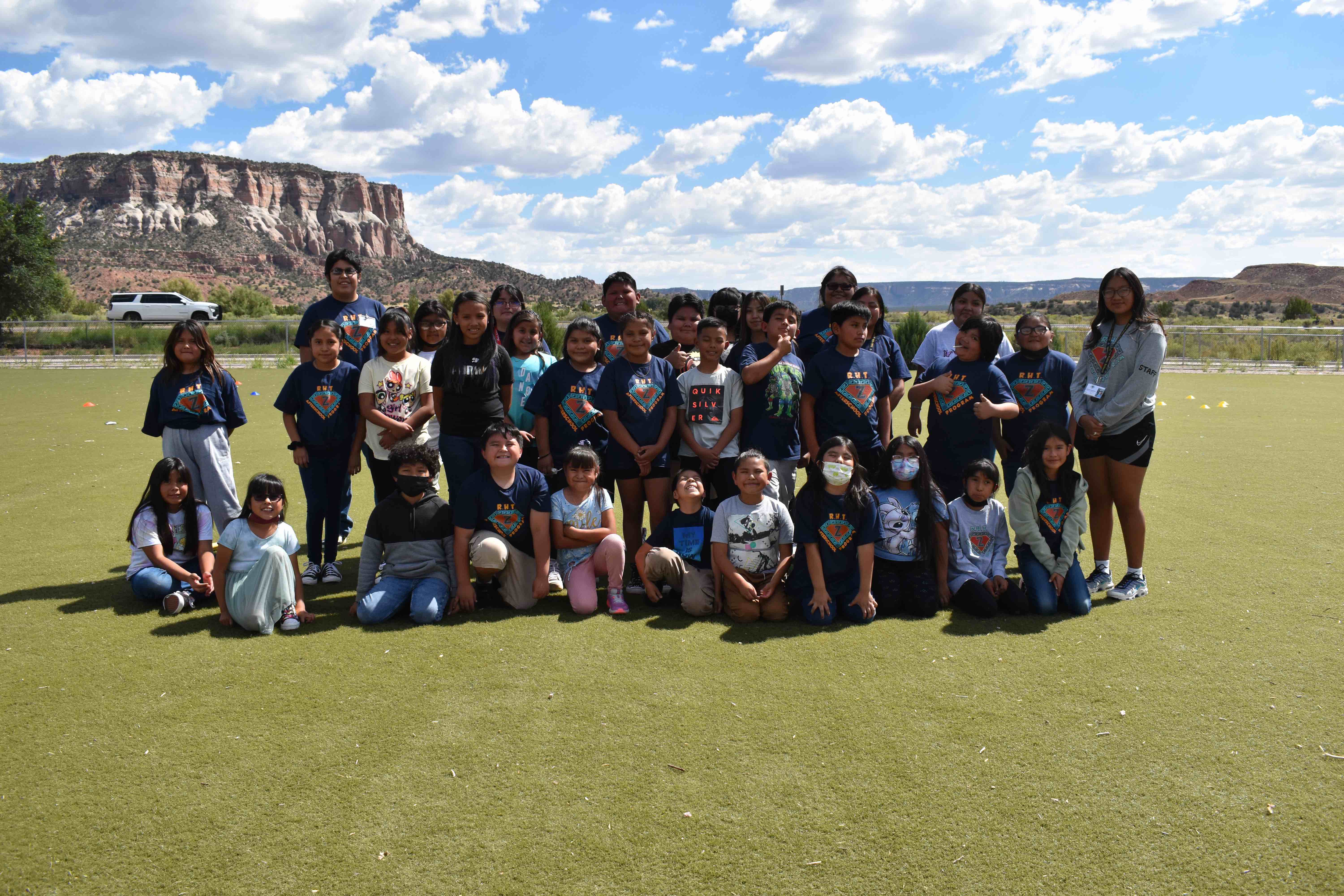
- Details
- By Native News Online Staff
With the 2023-24 school year underway, the Zuni Youth Enrichment Project (ZYEP) and Zuni Public School District are once again collaborating to offer both in-school and after-school programming for the community’s young people.
These include a holistic wellness class at Shiwi Ts’ana Elementary School, an art elective at Zuni Middle School, and the “Rooted in Healthy Traditions'' after-school program.
At the elementary level, what began as a performing arts class during the school day has evolved to incorporate all aspects of wellness. According to Kiara “Kiki” Zunie, ZYEP’s youth development coordinator, this transition has been a welcome development for staff and students alike.
“It’s a great approach, because it allows us to dive into so many different topics, including mental health and self-care,” she explained. “I was so excited to plan the curriculum with Rani (Yamutewa, one of ZYEP’s youth development leaders), and we’re grateful to Principal Janis Bowekaty for her support.”
The class, made possible with assistance from the New Mexico Department of Health, incorporates physical activity, food sovereignty education, and the “Eat Smart To Play Hard” state curriculum, as well as traditional storytelling, traditional dance and music. The ZYEP team also incorporates art as a way for children, especially the younger ones, to process how they are feeling.
“The young kids will draw to express what makes them happy, for example,” Zunie said. “The older students are more hesitant, but they do want to talk. So we’ll have a talking circle and give them a chance to explore questions like, ‘How do I turn my day around?’ We let them know this is a safe space, where everyone is welcome to share.
“As they process their emotions, they learn how to put them into words,” she continued. “A lot of our work revolves around reflection, and encouraging them to think about how they want to take care of their present and future selves.”
Next, with support from the Substance Abuse and Mental Health Services Administration (SAHMSA), the New Mexico Behavioral Health Services Division, and Dr. Dominique Dosedo, Zuni Middle School principal, and her ZMS team, the nonprofit youth project is partnering with 8th grade teacher Bryston Bowannie to offer an elective class that focuses on building resilience through art. Scheduled to be part of the regular school day, the elective is offered twice per year and rotates through three subjects: traditional dance, food sovereignty and art.
ZYEP Arts Leader Liam Simplicio is leading the class with assistance from ZYEP Arts Coordinator Elroy Natachu Jr. and Arts Assistant Coordinator Kandis Quam. The students are learning art foundations, such as drawing, shading, forms and colors; they’re also learning about the connections between art and traditional culture and the impact of art on daily Zuni life.
“It’s awesome to see the way Liam approaches the instruction, and I love the partnership with Bryston,” Zunie said. “Nearly half of the 18 students in the elective are new to art, and it’s wonderful to see them understanding it and getting into it. It’s their first class in the morning, so it gives them a chance to let out their feelings and stress through art, and then get on with their day.”
Finally, fall semester also is the time for “Rooted in Healthy Traditions,” ZYEP’s 10-week after-school program at Shiwi Ts’ana Elementary. It is made possible with support from the CDC’s Tribal Practices for Wellness in Indian Country and the New Mexico Department of Health.
The program takes place every Tuesday, Wednesday and Thursday from 3 to 5 p.m. During each session, children participate in physical activity and special focus areas that include traditional art, knowledge sharing, and food sovereignty. Forty-four children in third through fifth grades are currently participating, with two mentors assigned to each grade level
Fifth-graders comprise the largest group with 19 children. At press time, a few spots were still available for third- and fourth-graders; middle-schoolers will have their opportunity to participate in RHT once this 10-week session at Shiwi Ts’ana Elementary concludes.
“Our 10-week timeframe is new this year,” Zunie said. “We extended the program by four weeks, and we believe so much good will come from that. It was great to see that the kids missed us! Some of them have participated for multiple years now, so we’re seeing them grow up with ZYEP programming.
“They’re comfortable with us, they can vocalize their needs — they’ve been taking in the lessons,” she reflected. “Someday they might become youth leaders, and then they might even join our team. That is the dream.”
More Stories Like This
Native Students Can Win $5,000 Scholarship, International Distribution in Pendleton Design ContestAmerican Indian College Fund Raises Alarm Over Plan to Shift Native Programs Away From the Dept. of Education
MacKenzie Scott Foundation Gives $5 Million Contribution to Little Priest Tribal College
Tribal Leaders Push Back on Dismantling of U.S. Department of Education
American Indian College Fund Names 12 Student Ambassadors for 2025–26
Help us defend tribal sovereignty.
At Native News Online, our mission is rooted in telling the stories that strengthen sovereignty and uplift Indigenous voices — not just at year’s end, but every single day.
Because of your generosity last year, we were able to keep our reporters on the ground in tribal communities, at national gatherings and in the halls of Congress — covering the issues that matter most to Indian Country: sovereignty, culture, education, health and economic opportunity.
That support sustained us through a tough year in 2025. Now, as we look to the year ahead, we need your help right now to ensure warrior journalism remains strong — reporting that defends tribal sovereignty, amplifies Native truth, and holds power accountable.
 The stakes couldn't be higher. Your support keeps Native voices heard, Native stories told and Native sovereignty defended.
The stakes couldn't be higher. Your support keeps Native voices heard, Native stories told and Native sovereignty defended.
Stand with Warrior Journalism today.
Levi Rickert (Potawatomi), Editor & Publisher


